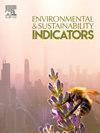Advancing air quality monitoring systems towards sustainable green development: Insight for metropolitan cities in Indonesia
IF 5.4
Q1 ENVIRONMENTAL SCIENCES
引用次数: 0
Abstract
Urban development, industrialization, higher living standards, and growing population, which have led to a decline in environmental quality, including air pollution, have become major concerns for decision-makers in many major cities in Indonesia. Air quality monitoring adopted by the Indonesian government has not produced timely, complete, continuous, and relevant data for effective policy and decision-making. This paper aims to provide insight for decision-makers on the potential implications of implementing an inclusive advanced air quality monitoring system in building effective and efficient air pollution mitigation for metropolitan cities in Indonesia. The method comprehensively reviews literature and other data sources on air quality monitoring and its significance. The results show that current air pollution monitoring systems failed to provide reliable data for effective control and mitigation, so more advanced and inclusive monitoring systems integrating Artificial Intelligence, cutting-edge technologies, and stakeholder involvement are urgently needed. The four main values of advanced air quality monitoring systems are: 1) real-time hotspot monitoring, 2) decision-making based on data/evidence, 3) increasing public awareness, and 4) improving the quality of spatial planning towards sustainable green development. This paper recommends implementing an advanced air quality monitoring system that combines technological infrastructure development with strengthening stakeholders' roles through the implementation of a quadruple helix interaction model, namely the interaction of four main innovation components: research/education, policy, business, and society. Badan Riset dan Inovasi Nasional (National Research and Innovation Agency) has developed SI PUBER, an IoT-based mobile air quality monitoring system to monitor urban pollution spatially and temporally in real-time and continuously.
推进空气质量监测系统以实现可持续绿色发展:对印度尼西亚大都市的洞察
城市发展、工业化、生活水平提高和人口增长导致包括空气污染在内的环境质量下降,已成为印度尼西亚许多主要城市决策者关注的主要问题。印尼政府采用的空气质量监测并没有为有效的政策和决策提供及时、完整、连续和相关的数据。本文旨在为决策者提供关于实施包容性先进空气质量监测系统在印度尼西亚大都市建立有效和高效的空气污染缓解方面的潜在影响的见解。该方法综合回顾了空气质量监测的文献和其他数据来源及其意义。研究结果表明,当前的大气污染监测系统无法为有效的控制和缓解提供可靠的数据,因此迫切需要更先进、更包容的监测系统,集成人工智能、尖端技术和利益相关者的参与。先进空气质量监测系统的四个主要价值是:1)实时热点监测;2)基于数据/证据的决策;3)提高公众意识;4)提高可持续绿色发展的空间规划质量。本文建议实施一个先进的空气质量监测系统,该系统通过实施四螺旋互动模型,即四个主要创新组成部分:研究/教育、政策、商业和社会的互动,将技术基础设施发展与加强利益相关者的作用相结合。巴基斯坦国家研究与创新机构(National Research and Innovation Agency)开发了基于物联网的移动空气质量监测系统SI PUBER,可以实时、连续地监测城市污染的空间和时间。
本文章由计算机程序翻译,如有差异,请以英文原文为准。
求助全文
约1分钟内获得全文
求助全文
来源期刊

Environmental and Sustainability Indicators
Environmental Science-Environmental Science (miscellaneous)
CiteScore
7.80
自引率
2.30%
发文量
49
审稿时长
57 days
 求助内容:
求助内容: 应助结果提醒方式:
应助结果提醒方式:


